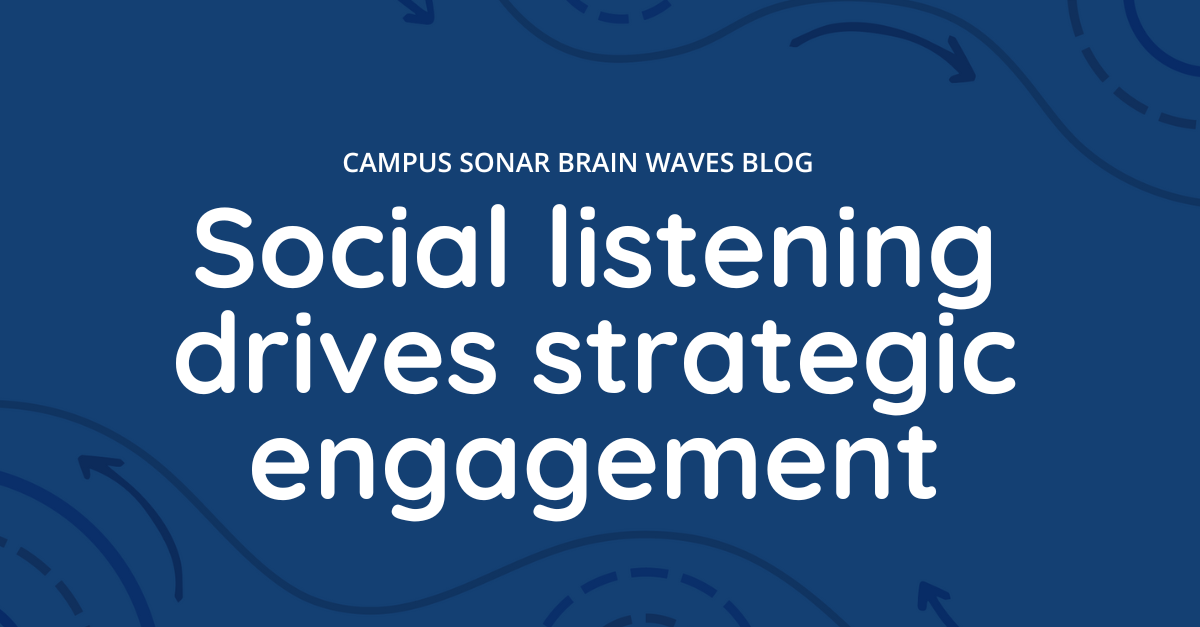Social Listening Drives Strategic Engagement

Higher education institutions of the future are prepared to identify and share their value with a variety of audiences—from students to donors to federal and state agencies and more. They know and advocate for their brand tirelessly and constantly evolve to meet the changing educational needs of the population. In short, the higher education institution of the future is equipped to drive growth in programs, enrollment, and advancement in ways that are efficient and innovative.A tool to drive growth in these areas is strategic engagement with key audience segments. Why engagement? Simply because people—whether prospective or current students, alumni, or donors—and their beliefs, preferences, and ideas, will focus how campuses approach and reach their key objectives.
One way to understand what your key audience segments are saying? Social listening. It’s the modern higher education professional’s tool to inform strategic, authentic, and consistent engagement efforts.
Why Social Listening?
Rather than tell an administrative professional or market researcher what they really think, people nowadays are more likely to go online and tell the internet. Listening to what people are saying online—whether by conducting social listening by searching social media channels manually or using dedicated social listening software—is a reliable, fast, and cost-effective way to gather qualitative data to inform engagement efforts. Social listening can help identify not only what your target audiences talk about, but when, how often, and where they tend to engage online.
Social Listening Helps You Understand Your Audiences
Whether you’re trying to reach current or prospective students, alumni, or donors, understanding what they talk about online and which topics are important to them can inform strategic campus efforts. For example, performing social listening can help higher education institutions gather intelligence on the following.
- Complaints from students about programming or course offerings
- Observations from prospective students and their families after visiting campus
- Feedback from alumni and donors about topics that are important to them
- Trending topics with a specific audience segment
Audience Intelligence Means Better Outcomes
So you’ve performed social listening (maybe for one or more of the reasons outlined above) or you’re thinking about doing so. How do you use the intelligence collected to inform engagement strategies—and what kind of outcomes could you expect?
Short-Term Impact of Intelligence-Informed Engagement
Day-to-day awareness of your audiences’ successes, struggles, and observations can help you dedicate the right amount of time and resources to respond appropriately online. In the short term, by listening closely to your audiences, you’ll be able to work toward improving…
- Customer service with prompt, personal, and professional intervention online.
- Perception of your institution as helpful and available as you respond to individual’s needs.
- Communication gaps between what you know—and what your audiences believe.
Social Listening Is a Long-term Investment
While performing social listening can help higher education institutions get closer to their audiences in an impactful way in the short term, social listening truly proves its value over the long term. It’s a great way to gather data that informs specific strategic campaigns, and it provides a way to track an institution’s performance over time toward its goals. As a research tool, social listening can provide long-lasting value by helping…
- Preserve and measure reputation as you track the volume and type of complaints or observations that are solved, arise, or trend seasonally online.
- Improve yield rate over time and conserve campus resources to engage strategically with target prospective students.
- Increase donations by adjusting the messaging of ask campaigns to align with topics that resonate with alumni.
- Evaluate demand shifts and respond to course and program feedback on an organizational level to meet the educational needs of your market.
Higher education institutions can find almost immediate benefit through performing social listening, but the real value of social listening is over the long term: it supports the higher education institution of the future to drive strategic engagement efforts that help reach institutional goals. Dive into what the higher education social listening landscape looks like with The Higher Ed Social Listening Handbook, and learn more tips to conduct social listening, a strategic model for social listening in higher education, as well as key social listening metrics, how-to guides, and over a dozen campus case studies related to social listening to crisis management, student engagement, brand management, influencer marketing, and audience research.
